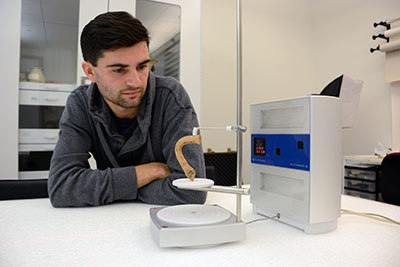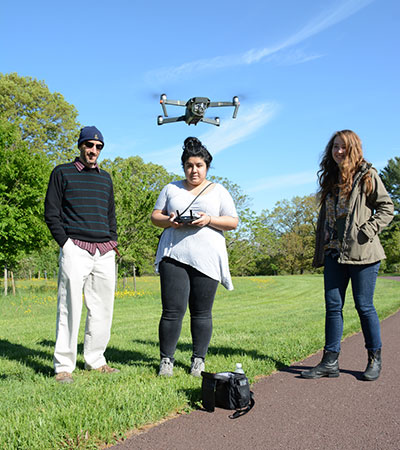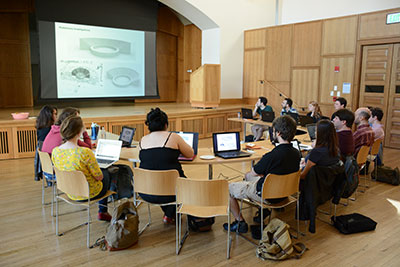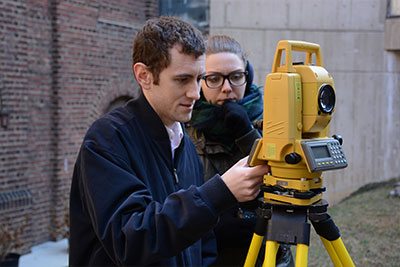Computers are integral to everything we do in archaeology today. In Fall 2016, the Center for the Analysis of Archaeological Materials (CAAM) reached completion with the addition of the Kowalski Teaching Specialist in Digital Archaeology. Over the course of the academic year, two new digital research methods classes were introduced into the curriculum to help Penn students remain at the forefront of the field.

Digital archaeology focuses on improving how we work with evidence of the human past. Data forms the basis of our archaeological conclusions, and digital methods enable the flexible manipulation and inquiry of ever larger datasets. Digital archaeology sits at the interface of the future and the past, pushing forward the state of the art in how we collect, analyze, and share information.
CAAM consists of multiple labs for conducting scientific research, and the newest lab for digital work is not a physical space but a virtual one. Students and researchers share a computer on the Internet, a “cloud” server. The server is accessed through virtual desktops: the users experience the desktop as if they are sitting at the remote computer since they see their files and can run all their normal programs. Yet by centralizing data, this server enables the direct collaboration between different users on the same files and databases. The virtual desktop also provides licensed software like ESRI’s ArcGIS and can be accessed anywhere in the world, including from the field.
Penn students are gaining experience with key digital methods in the new CAAM Virtual Lab, focusing on the three main steps in the data lifecycle: collecting, analyzing, and sharing. At the heart of any digital archaeology project is the database, a place to organize a research project’s evidence. Relational databases have a long history of use in many fields, including archaeology, and this technology has a mature and robust toolset for creating and using data structures. In the Lab, students are currently building archaeological databases in software such as the open source PostgreSQL.

Archaeologists have always studied the three-dimensional world, but have been limited to the recording of spaces and objects in 2D. Luckily, over the past decade, our ability to apply 3D methods has greatly improved. Students need to understand how to work with 3D in the digital realm, to conduct spatial analysis studies on landscapes and architecture, or to study the shapes of objects. Over the coming decade, augmented reality (AR) will become a key technique for investigation of the past. The AR method works by projecting 3D models into the real world surrounding the user, usually on transparent glasses. Among many possible applications, one can imagine a time when archaeologists use this technology to see previously removed contexts in an excavation trench.
In Fall 2016, the class Introduction to Digital Archaeology provided an opportunity for a mix of undergraduate and graduate students to gain experience with a variety of new digital methods used by archaeologists during field research. Student presentations and discussions of published case studies demonstrated how others have successfully applied these methods. We also studied the importance of the open access publication of archaeological datasets in order to advance the field through data reuse.
During spring 2017, the graduate-level class Spatial Analysis of the Past introduced students to a range of methods for studying space in archaeology at multiple scales—from individual contexts to entire landscapes. We covered the latest tools for collecting and analyzing data about space, from traditional 2D GIS to 3D modeling and photogrammetry. Students particularly enjoyed learning how to fly unmanned aerial vehicles (UAVs or drones), which are helpful for documenting landscapes. After practicing with a lightweight drone in the Mosaic Courtyard of the Museum, students traveled to the Morris Arboretum for training sessions on a professional drone over an open landscape.


To support this student training, CAAM purchased a DJI Mavic Pro drone, a portable yet stable platform for capturing imagery from the air. This adds to a growing list of digital tools available to archaeology students at the Museum and around campus. A course development grant from the Museum’s Academic Engagement Department made possible by the Andrew W. Mellon Foundation enabled the purchase of the photogrammetry software Agisoft Photoscan Pro for the Virtual Lab. Thanks to the support of the Price Lab for Digital Humanities, CAAM is now testing new affordable differential global navigation satellite systems (GNSS) equipment for field use. The Penn Libraries are acquiring the latest tools for 3D scanning and augmented reality for student use. CAAM has also been working with students in Penn Engineering to develop software for field archaeology.
Over this past year, digital archaeology classes have focused on training graduate students and upper-level undergraduates. In Fall 2017, a new undergraduate digital humanities course, The Material Past in a Digital World, will introduce non- and early-archaeology students to digital methods for studying objects. CAAM looks forward to advancing all things digital archaeology during Penn’s 2017–18 Year of Innovation. For more information on CAAM classes, visit penn.museum/caam.
